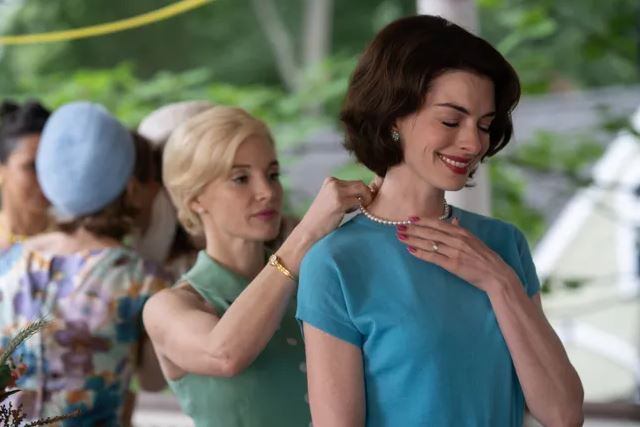
Spoiler alert! We’re discussing major plot details and the ending of “Mothers’ Instinct” (now in select theaters; available Aug. 13 as video on demand).
Some people would kill to be parents.
That’s the dark premise of “Mothers’ Instinct,” a suspenseful new thriller starring Anne Hathaway and Jessica Chastain as next-door neighbors whose friendship sours after the death of one of their young sons. This twisty period drama features Oscar-winning actresses chain-smoking in fabulous wigs and diving into a story about grief and revenge.
The movie is based on the 2012 novel “Behind the Hatred” by Belgian author Barbara Abel, but substantial changes have been made in the film adaptation. Here are some of the biggest differences between the book and movie:
Character names and setting changes in ‘Mothers’ Instinct’
One major difference is the film’s setting in a 1960s suburban American neighborhood, while the book takes place just outside Paris in the recent past, with references to watching “SpongeBob SquarePants” and playing Nintendo games. The characters’ names have also been changed: Laetitia is now Alice (Chastain), Tiphaine is now Celine (Hathaway), and so on.
Max’s tragic fall differs in the ‘Mothers’ Instinct’ book
In the book, Celine’s son Max (Baylen D. Bielitz) stays home sick from school, and while trying to cool down, he opens his bedroom window, leans out too far, and falls to his death. The film changes these circumstances: Max is still home ill, but he goes out to the balcony to adjust a birdhouse in a nearby tree, loses his balance, and falls.
In both versions, Alice is in her backyard next door when Max falls. Unable to get through the hedge separating the houses, she runs to the front door of Celine’s home for help but is too late. The book devotes many chapters to whether Alice could’ve saved Max by breaking his fall and the importance of a pathway connecting both yards. Fortunately, the film prunes most of these landscaping disagreements.
Jessica Chastain’s ‘Mothers’ Instinct’ character has a richer backstory
The film fleshes out Alice’s character. In the book, she loses her parents in a car accident before meeting her future husband, Simon (Anders Danielsen Lie), who helps her through her grief. The film, however, adds more depth: Alice feels immense guilt for surviving the car crash that killed her parents, suffers from anxiety, takes medication, and quits her journalism career after multiple stays in mental hospitals. Simon is skeptical when Alice starts accusing Celine of murder, adding suspense: Is Alice an unreliable narrator, or is she right to fear Celine?
‘Mothers’ Instinct’ ending differs significantly from the book
The film’s last 30 minutes diverge significantly from the book. In the novel, Celine, a former pharmacist, tries to poison Theo using a herbal remedy disguised as Doritos dust. In the film, Celine’s husband, Damian (Josh Charles), works in pharmaceuticals, and Celine instead tries to weaponize Theo’s peanut allergy by feeding him peanut butter cookies.
In the book, Simon is an ex-con and recovering addict. His sponsor, Ernest, becomes Theo’s godfather and is Celine’s first victim. All of this is cut from the film: Instead, Celine kills Alice’s mother-in-law (Caroline Lagerfelt) to ensure Theo has no close relatives to care for him if his parents die.
Anne Hathaway’s ‘Mothers’ Instinct’ character is more sympathetic
Celine has a higher body count in the movie. In the novel, she and Damian kill both Simon and Alice, framing their murders as suicides, and gain custody of Theo. In the film, Celine works alone: She kills Damian in his sleep, making it appear as if he slit his wrists. Alice, feeling pity, invites the newly widowed Celine to stay at their house. One night, Celine chloroforms Alice and Simon and stages a gas leak to make their deaths look accidental.
The book ends with a child therapist telling Celine and Damian that Theo is lucky to have them as parents. The film, however, concludes on a more sentimental note with Celine and Theo walking gloomily on the beach. Tearfully, she reassures Theo that they can help each other heal, and they begin to play on the sand as the credits roll.
For all its high-camp moments – of which there are many – the movie ultimately works better than the book on an emotional level. Hathaway and Chastain are both attuned to the film’s pitch-black humor and Hitchcockian melodrama, and they achingly convey their characters’ desperation and resentment. It turns out there are no limits to a mother’s love.













